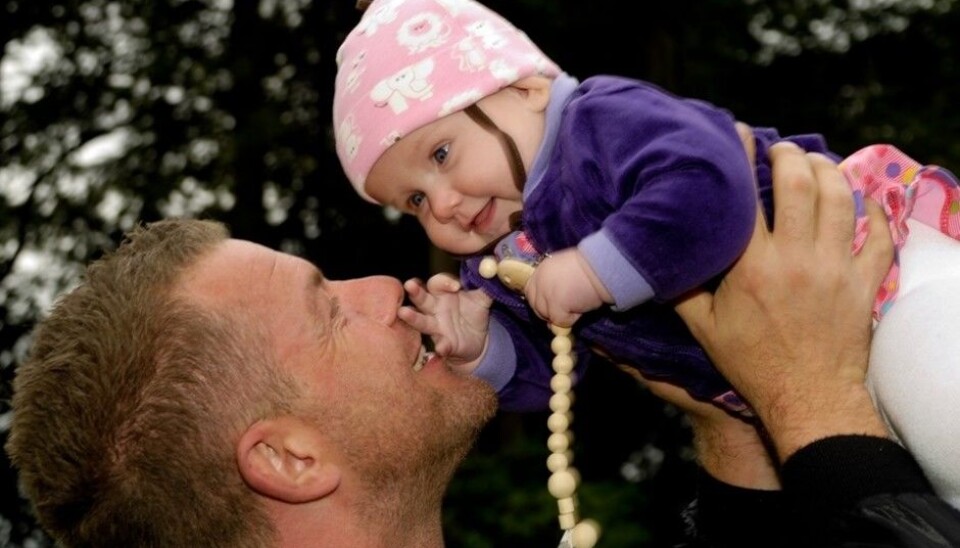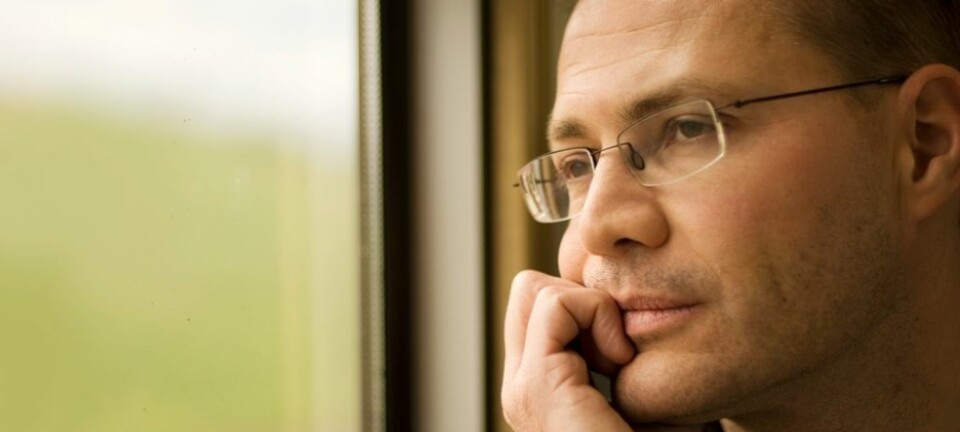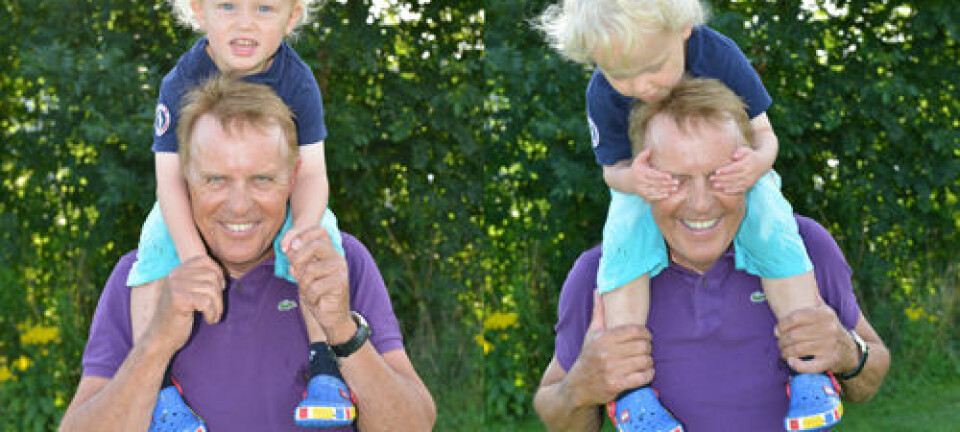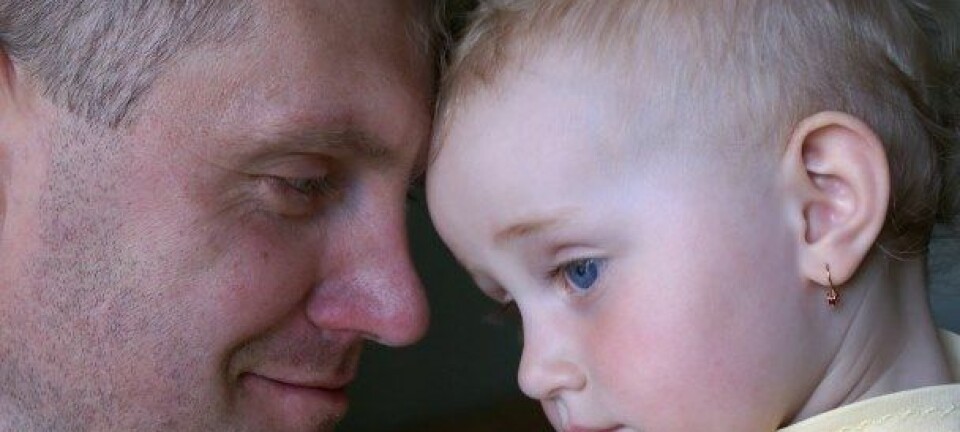An article from KILDEN Information and News About Gender Research in Norway

A nurturing father has a positive influence on a child's development
But only if he spends a considerable amount of time with the child during its first year.
Denne artikkelen er over ti år gammel og kan inneholde utdatert informasjon.
Being a sensitive and attentive dad doesn’t help if you don’t spend enough time with your child. However, time isn’t enough in itself.
"It's the combination of time and quality that has an impact," says researcher Kristin Berg Nordahl.
Nordahl recently defended her PhD thesis on fathers’ interaction with their children at the University of Bergen.
Her research shows that children with fathers who had spent a lot of time at home with their child during the first year, showed less signs of disruptive behaviour at the age of two.

This was only the case however, if there was positive interaction between father and child.
Children who had spent a lot of time with fathers who interacted with the child in a negative way showed poorer social competence at the age of three.
Nordahl recently became involved in the debate on paternal leave in Scandinavia. Her advice to fathers is clear: Try to get leave from work in order to spend as much time as possible with your child during its first year. But above all; make sure you spend high quality time with your child.
Recorded father-child interactions
Nordahl’s PhD thesis is part of a major project at The Norwegian Centre for Child Behavioural Development. Fathers and mothers of 1157 children are interviewed and observed at regular intervals as their children grow older.
Nordahl’s main source of data is from video recordings of the interaction between 750 of these fathers and their one year old child.
First, father and child were playing freely for about four minutes with toys suitable for the child’s age. Then the toys were put away, and the child was given a sorting box in which to put blocks of various shapes. After three minutes this was replaced by a stacking toy. Finally the child had to wait in a high chair without access to any toys while the fathers filled in a form.
A control selection of 40 mothers were recorded in the same way.
The interactions were coded by the use of standardised score systems.
Negative and positive response
So-called positive interaction is characterised by a responsive dad who is sensitive and pays attention to the child’s signals. It is about seeing and communicating well with the child. In the interaction with a one-year-old this might mean that the father is patient, that he pays attention to what the child is interested in and perhaps initiates playing or games if this is needed.
Negative interaction, on the other hand, is characterised by the father leading and controlling the playing without waiting for the child’s reaction. The father might interrupt the child by introducing new toys, or stop the child’s initiative by saying things like “No, not this way”, causing the child to lose interest or resist.
Few of the fathers who took part in Nordahl’s study engaged their children in negative interaction. Rather, there were degrees of positive and negative interaction. 15 percent of the fathers had more than one episode of negative interaction.
"All parents sometimes engage their child in negative interaction," Nordahl emphasises.
Fathers more positively engaged
In a smaller selection of 39 families, the study showed that the fathers were more positively engaged with the child than the mothers, but only when the child was a boy.
Positive engagement is defined by the sum of all positive expressions and actions such as initiating a game, organising a game, giving praise, encouragement and smiling.
"If the child was a girl, the mothers and fathers were equally positively engaged. And it didn’t make any difference to the mothers whether the child was a boy or a girl", says Nordahl.
This corresponds with international research which has also showed that fathers of male children are more positively engaged than fathers of female children.
According to Nordahl Norwegian research on fathers cannot always be compared to similar research outside the Nordic countries, since the Norwegian state to a greater extent facilitates contact between father and child. However, in this case she found the same tendency among Norwegian fathers as has been shown in studies from other countries.
"On the other hand, there was no difference in terms of how much mothers and fathers spoke to their child. This contradicts previous research, which has found that mothers talk to small children more than fathers do," says Nordahl.
Play-parent versus caring-parent
Nordahl’s thesis primarily investigates what happens during the interaction; not why it happens. Nevertheless, she does offer possible explanations to the gender differences.
"The fathers’ more positive engagement during interaction may have to do with parenting roles, without it necessarily having to do with gender. As mothers give birth and breast feed, they are almost always at home with the child first. Fathers usually enter the role as the daily care person at a later stage. This might lead to him becoming the 'fun and play parent'," says Nordahl.
Previous research has shown that in families where the mother works outside the home while the father is home with the child, the mother plays the most with the child.
"But the fathers were more positively engaged with the child only if it was a boy? Why is that?"
"This is an interesting question, but so far research hasn’t found any clear answers. Perhaps men feel more secure with boys, or they perceive themselves as more important role models for sons than for daughters? Or maybe they are more careful with girls? Or is this perhaps really about the mother keeping her daughter closer to herself?"
Girls more positive
Despite the fact that the boys experienced more positive engagement on the whole from their parents, the girls were more positively engaged during interaction with their parents. Among other things, the girls showed more initiative by offering toys to dad and they responded more positively to similar initiatives from dad.
"I was very surprised to find gender differences at such an early stage. This is interesting, and something I wish to look further into," says Nordahl.
Include dad as early as possible
The thesis’ most important finding is that both spending time with the child and the quality of the interaction during this time is important in understanding the fathers’ role and his significance for children’s social development. According to Nordahl this should have practical consequences for the way in which fathers are included in the daily care for children.
"Dads are more present in their children’s lives, and increasingly so at earlier stages. The quality of their care becomes vital when the fathers spend a lot of time at home during that first year. So there is a need for us to get better at securing the quality of the care, as we already do for mothers," she says.
"We have studied maternal care for a long time. The effect of spending time with your child hasn't really been an issue for research on maternal care so far, since mothers traditionally spend a lot of time with their children. With the introduction of paternal leave and greater expectations concerning fathers’ participation in parenting in general, the way fathers spend their time is a relatively new topic and therefore very interesting," says Nordahl.
She emphasises that experience and knowledge about child care is still today transferred from mother to daughter, a knowledge young fathers therefore lack. Possible problems in the early interaction between mother and child are also picked up sooner, since in most families the mother is the one who is normally in touch with the public health centre during the child’s first few months.
"In general, Norwegian public health centres are doing an excellent and very important job. But they could still get better in terms of including fathers at an earlier stage and in the same way as mothers," says Nordahl.
"They could, for instance, offer short courses on early interaction and on how fathers might have a positive influence on their children’s development. They could also get better at establishing paternity groups. Perhaps the public health centres should hire more men."
Pro paternal leave
Nordahl has not done any research on the father’s quota of parent leave as such; neither has she measured how the parents in her study have divided the parental leave between them.
"We only asked the fathers how many months they have spent at home with their child during its first year," says Nordahl.
"What I can establish, however, is that more time with dad seems to have positive effects on the child’s social development as long as this time is characterised by positive interaction. Thus I would claim that fathers should be entitled to spend more time with their children, and they should be entitled to guidance in order to enhance the quality of the interaction between father and child."
------------
Read the Norwegian version of this article at forskning.no
Translated by: Cathinka Dahl Hambro



































